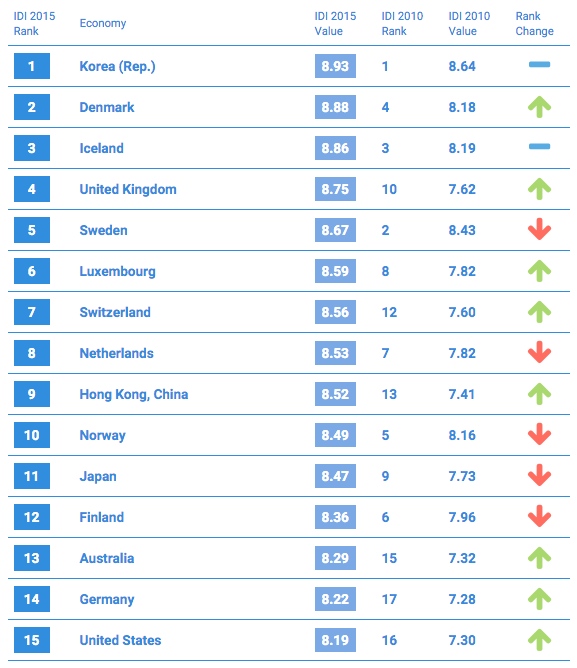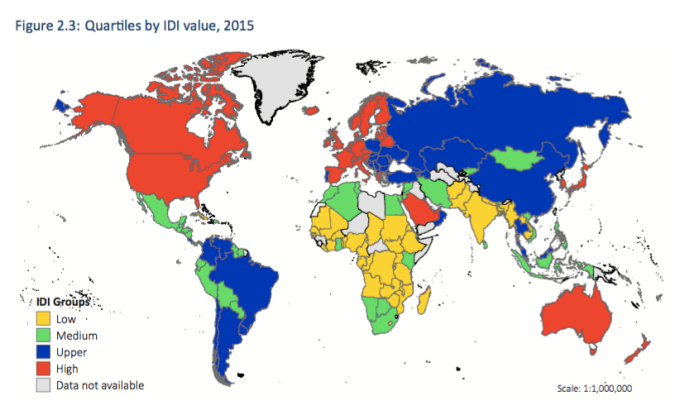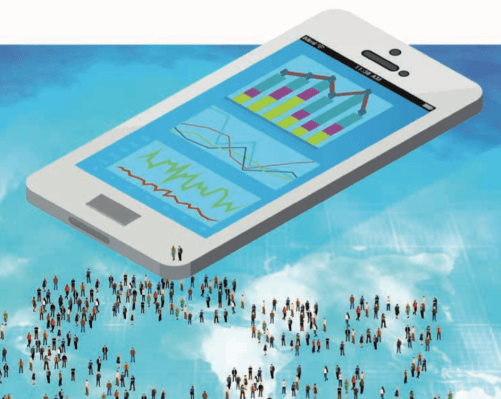Overall, there are now 3.2 billion people online, but mobile networks continue to lead the way when it comes to connecting people for the next generation of communications: Mobile subscriptions are now at 7.1 billion globally, and more than 95% of the world’s population are now within reach of a mobile network signal, according to International Telecommunication Union, which today published its annual global survey charting progress across developed and emerging markets.
The Republic of Korea — a very early adopter both in fast, affordable broadband and next-generation mobile services — has held on to its spot as the most-connected place in the world when it comes to Internet connectivity and how well data services are adopted in the country, .
South Korea was followed by a stream of European countries alongside Hong Kong and Japan, with the U.S. moving up one spot to number 16 in the list.

Interestingly, the list does not necessarily correlate with how fast an economy is growing or the impact it may have on the wider tech market as a result of that. Mainland China, for example, which is such a crucial market for the likes of Apple and others, ranks at number 82 in the ITU’s index, moving up only five places in the last five years. And India is at 131, having moved down six places.
On one hand, this points to how there is still a lot of work to do to big, promising countries like China and India completely connected; on the other, it underscores the massive potential for growth that still remains.
The ITU’s figures show that just as mobile cellular subscriptions have overtaken those of fixed phone subs, mobile broadband subscriptions (47.2%) have now overtaken not only fixed-broadband subscriptions (mere 10.8%), but households with Internet access (46.4%).

The converse of the “good news” numbers is that there are still some 350 million people globally who have access to nada in the way of Internet access, mobile or otherwise. These include people in some of the poorest countries in the world, such as Malawi, Madagascar, Ethiopia, Eritrea and Chad, which are the five least-connected countries globally in descending order (referred to by the ITU as LDCs, for least-developed countries).
This is one of the gaps that companies like Google, with its Project Loon; and Facebook with its newly-renamed “Free Basics” program for mobile broadband from Internet.org, are hoping to address. The other gap in the market that these commercial groups are targeting is the fact that even in some places where there is connectivity, it’s hard for people to access because of price.
The ITU notes that tariffs for mobile services continue to fall — in the LDCs of the world, prices are now at 14% of gross national income per capital versus 29% in 2008, with mobile broadband seeing the biggest drops. But it notes that despite some major advances, there are still 22 developing countries with broadband prices (fixed or mobile) that are over 20% GNI p.c..
Interestingly, it looks like the gap between fixed and mobile usage will only continue to grow. The ITU notes that in the LDCs, the price of broadband is actually increasing again.
“In the LDCs in particular, fixed-broadband services remain unaffordable, and most of the countries ranked at the bottom of the fixed-broadband basket are LDCs,” the ITU writes. “The 2014 average fixed-broadband basket corresponded to 98% of GNI p.c. in LDCs, up from 70% a year before, a sharp increase that will not improve the already very low uptake of fixed broadband in the world’s poorest countries.”

This is not the only gap that is emerging, the ITU notes. While we’ve talked a lot in the past about a digital divide between rich and poor nations, the ITU is finding that the gap at the moment appears to be between middle-ranking countries and the very poorest.
“Over the past five years, there has been a widening of the gap in IDI values between countries ranked in the middle and those towards the bottom of the distribution,” the ITU notes. “In the LDCs, the [ICT development index, or IDI] grew less compared to other developing countries and LDCs are falling behind in particular in the IDI ‘use’ sub-index, which could impact on their ability to derive development gains from ICTs.”
This indicates in a way that there is a generally improving “middle class” of countries when it comes to ICT growth, but that there is also a group that, worryingly, appears to be falling increasingly behind.
You can get the full Measuring the Information Society report here.
